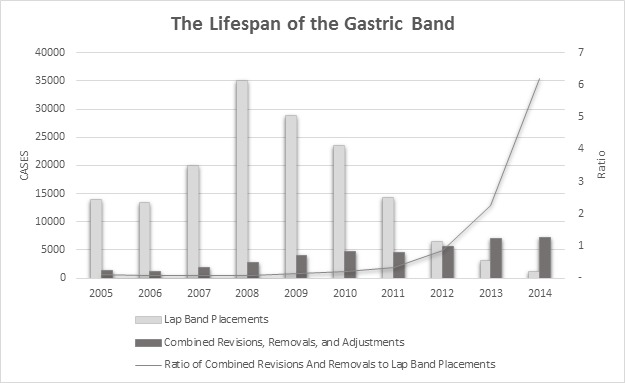|
Back to 2017 Posters
HAVE WE REACHED THE END OF THE LIFESPAN OF LAPAROSCOPIC BANDING FOR MORBID OBESITY?
Marek Rudnicki, Andres E. Giovannetti*, Kenneth W. Bueltmann
Surgery, Advocate Illinois Masonic Medical Center, Chicago, IL
Introduction:
Laparoscopic placement of band on the proximal stomach (lap band) was recommended by many authors to treat morbidly obese patients for several years. As with any other bariatric procedure, lap band requires the evaluation of long term outcomes. The aim of this study was to assess trends in gastric lap band placement, its surgical adjustments, revisions, and removals in the USA.
Methods:
The Nationwide Inpatient Sample (NIS) was queried for all lap band placements (ICD9 44.95), adjustments of gastric restrictive devices, revision of gastric restrictive procedures and removal of gastric restrictive devices (ICD9 44.98, 44.96, 44.97 respectively). Since the iintroduction of these codes in 2005, they have been used for procedures related to lap band placements, adjustments, revisions and removals. Trends in number of procedures, geographic locations, length of stay, comorbidities and mortalities were evaluated by NIS z score calculator with p < 0.05 considered significant. Chi-square and Pearson correlation tests were used to look for association between categorical variables. Comparisons were considered significant only if the p value was < 0.05.
Results:
Between the years 2005 and 2014, 159,890 patients underwent laparoscopic band placements. Utilization decreased from 13,933+2844 in 2005 to 1170+147 in 2014 (p<00001), peaking in 2008 at 35,051+4805 cases. Total number of repeated procedures during the same period of time increased from 1405 to 7240 in 2014 (increase by 432%). This number does not include standard band adjustments after surgical procedure. Combined rate of adjustments, revisions, and removals increased from 10% in 2005 to 619% in 2014 when compared to bands placed in the same year. The total rate of removal over the studied period was 17% of the total number of bands placed. Multiple significant trends were identified in all other measured parameters.
Conclusion:
The number of revisions and removals increased steadily over the years. Approximately10 patients obtained lap bands per one band removed or revised in 2005, whereas in 2014, American surgeons performed six times more removals and revisions of bands than actual original band placements to address morbid obesity.
Considering these findings, surgical treatment of bariatric patients with laparoscopically placed banding should be considered very carefully if not completely abandoned. These findings add to the ever going conundrum of treatment of patients with morbid obesity.

Back to 2017 Posters
|


